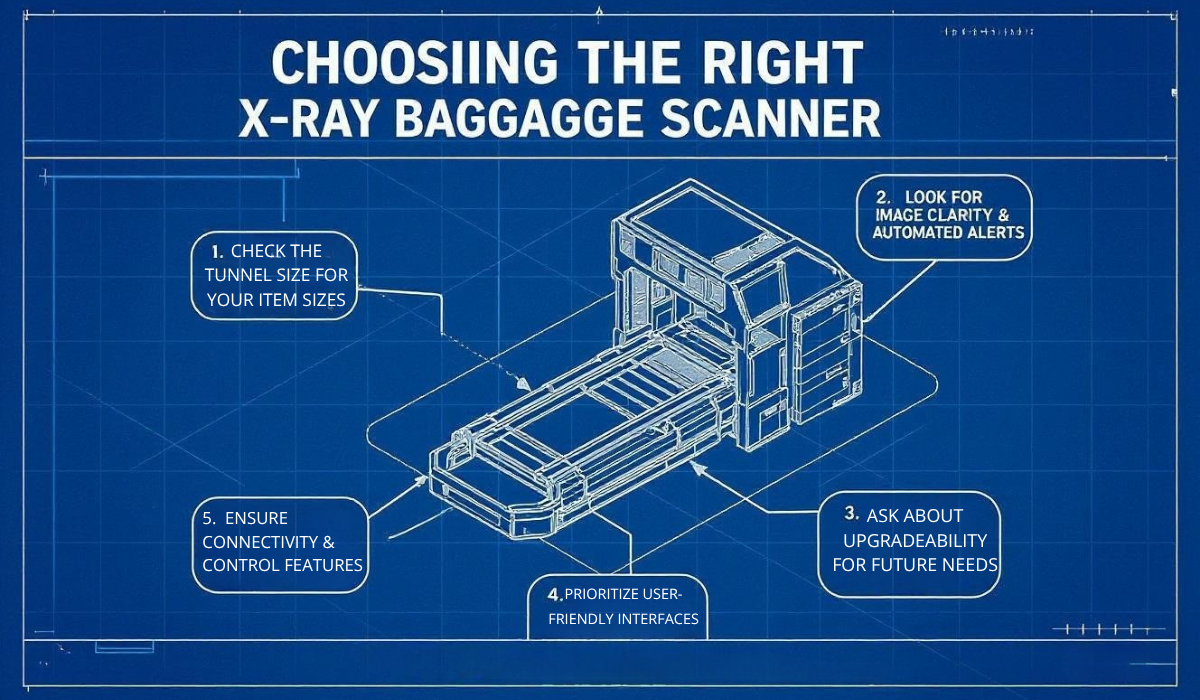If you’re in charge of keeping people safe and secure at an airport, a logistics hub, a school, or a government building, pick the right baggage scanner is a very important choice. It’s essential to choose a scanner that matches your specific demands while also being reliable, flexible, and offering peace of mind as risks evolve and technology advances.
How will you pick the Right Baggage Scanner? Learn about the different models.
There are several different types of X-ray baggage scanners, each made for a certain job. Before you buy, think about where and how the scanner will be used:
- Conveyor belt scanners are often used in airports and huge venues. They can handle a lot of objects and rapid throughput.
Portable and compact baggage scanners are appropriate for tiny offices, event venues, and checkpoints with lesser traffic. - Dual-View or Multi-Energy Systems: Give you extra angles and better detection of hidden hazards.
- Specialized Baggage Scanners: For large shipments, pallets, or other industrial demands.
- Think about the size and type of things that will most likely go through your baggage scanner. If you pick the wrong model, it could cause problems with operations or leave security holes.
- Tunnel Sizes and Throughput: Finding the Right Fit Tunnel size is very important because it defines the largest item that may be checked:
- compact tunnels (like 500mm by 300mm) are great for handbags, backpacks, and compact packages.
- Medium Tunnels (like 600mm x 400mm): Good for regular-sized bags and briefcases.
- Large and Extra-Large Tunnels (up to 1000mm x 1000mm and bigger): These are needed for big bags, logistical packages, or bulky goods that are common in industrial settings.
Larger tunnels can do more things, but they take up more floor space. Estimate how much work you can do at your busiest time: How many bags do you need to check every hour? Pick a model that can keep up; check the specifications for belt speed and picture processing rate.
Evaluating Features: What Matters Most
There are a lot of features in modern baggage scanners. Look for these important features:
- Image Clarity & Automated Alerts: Operators can find hazards fast and accurately thanks to high-resolution imaging and computer-aided detection (CAD).
- Touch screens, easy-to-understand controls, and customisable settings make it easier to learn how to use the software and make fewer mistakes.
- Networking Features: Central control and compliance tracking are possible because of remote monitoring, data storage, and system updates.
- Safety Features: Shielding and regulatory certifications keep both operators and the public safe.
- Dependability, Upgradability, and Ease of Use
It is really important to be reliable. Ask about the service’s history, warranty terms, and whether or not technical support is available. Frequent maintenance problems might bring operations to a halt.
Your baggage scanner will stay useful as threats change if it can be upgraded. Systems that have modular parts, can be updated with new software, and can use plugins last longer and are worth more in the long run.
How easy it is to use affects both security and speed. Controls should be easy to use, systems should support multiple languages, and they should be easy to get to for cleaning and maintenance.
Logistics Tips to Pick the Right Baggage Scanner for Your Industry
To keep goods moving, give scanners with big tunnels and high throughput first priority.
- To find organic and inorganic hazards buried amid different commodities, look for imagery with a lot of contrast.
- Schools: Choose small, easy-to-use scanners with strong safety features.
- Look for machines that run quietly and have simple controls for non-technical people.
- Government Buildings
For more security, think about using dual-view or multiview systems. - Put money into models that support networking and centralised picture archiving for audits and compliance.
- Important Things to Know Before You Buy
Think about how much room, volume, and type of thing you require. - Check out models based on their tunnel size, throughput, and special detecting features.
- Take into account how reliable it is, how good the service is, and how easy it will be to update in the future.
- Make sure your choice fits with the problems and realities of your industry.
Making an informed choice will keep everyone in your facility safe, protect them for a long time, and make daily operations go smoothly.

